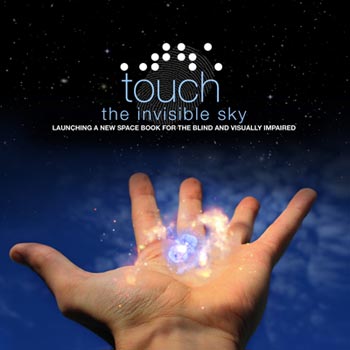January 15, 2008
NASA Release: 08-007
BALTIMORE - At a Tuesday ceremony at the National Federation of the Blind, NASA unveiled a new book that brings majestic images taken by its Great Observatories to the fingertips of the blind.
"Touch the Invisible Sky" is a 60-page book with color images of nebulae, stars, galaxies and some of the telescopes that captured the original pictures. Each image is embossed with lines, bumps and other textures. These raised patterns translate colors, shapes and other intricate details of the cosmic objects, allowing visually impaired people to experience them. Braille and large-print descriptions accompany each of the book's 28 photographs, making the book's design accessible to readers of all visual abilities.
The book contains spectacular images from the Hubble Space Telescope, Chandra X-ray Observatory, Spitzer Space Telescope and powerful ground-based telescopes. The celestial objects are presented as they appear through visible-light telescopes and different spectral regions invisible to the naked eye, from radio to infrared, visible, ultraviolet and X-ray light.
The book introduces the concept of light and the spectrum and explains how the different observatories complement each others' findings. Readers take a cosmic journey beginning with images of the sun, and travel out into the galaxy to visit relics of exploding and dying stars, as well as the Whirlpool galaxy and colliding Antennae galaxies.
"Touch the Invisible Sky" was written by astronomy educator and accessibility specialist Noreen Grice of You Can Do Astronomy LLC and the Museum of Science, Boston, with authors Simon Steel, an astronomer with the Harvard-Smithsonian Center for Astrophysics in Cambridge, Mass., and Doris Daou, an astronomer at NASA Headquarters, Washington.
"About 10 million visually impaired people live in the United States," Grice said. "I hope this book will be a unique resource for people who are sighted or blind to better understand the part of the universe that is invisible to all of us."
The book will be available to the public through a wide variety of sources, including NASA libraries, the National Federation of the Blind, Library of Congress repositories, schools for the blind, libraries, museums, science centers and Ozone Publishing.
"We wanted to show that the beauty and complexity of the universe goes far beyond what we can see with our eyes!" Daou said.
"The study of the universe is a detective story, a cosmic 'CSI,' where clues to the inner workings of the universe are revealed by the amazing technology of modern telescopes," Steel said. "This book invites everyone to join in the quest to unlock the secrets of the cosmos."
"One of the greatest challenges faced by blind students who are interested in scientific study is that certain kinds of information are not available to them in a non-visual form," said Marc Maurer, president of the National Federation of the Blind. "Books like this one are an invaluable resource because they allow the blind access to information that is normally presented through visual observation and media. Given access to this information, blind students can study and compete in scientific fields as well as their sighted peers."
The prototype for this book was funded by an education grant from the Chandra mission and production was a collaborative effort by the NASA space science missions, which provide the images, and other agency sources.
For more information on NASA's Great Observatories, visit:
http://www.nasa.gov
http://chandra.harvard.edu/edu/touch/
and
http://chandra.nasa.gov
MEDIA CONTACTS
Grey Hautaluoma
Headquarters, Washington
Jan. 15, 2008
202-358-0668
grey.hautaluoma-1@nasa.gov
Megan Watzke
Chandra X-ray Center, Cambridge, Mass.
617-496-7998
mwatzke@cfa.harvard.edu
Ray Villard
Space Telescope Science Institute, Baltimore
410-338-4514
villard@stsci.edu
Chris Danielsen
National Federation of the Blind, Blatimore
410-659-9314 ext. 2330
cdanielsen@nfb.org




